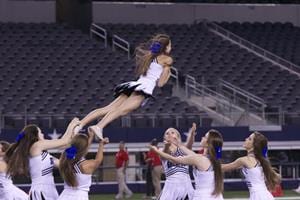Winter Fitness Tips for the Rest of Us Do you have family members, close friends…

Sport or Not, Cheerleading Has a Serious Side
 Is cheerleading actually a sport? At one level, the question is really only important because the technical definition (Is something a “sport” or just an “activity”?) determines whether or not athletic departments at federally funded educational institutions can count it for Title IX gender equality compliance purposes. But-at another level-the question also matters for cheerleaders themselves and for the community that supports them.
Is cheerleading actually a sport? At one level, the question is really only important because the technical definition (Is something a “sport” or just an “activity”?) determines whether or not athletic departments at federally funded educational institutions can count it for Title IX gender equality compliance purposes. But-at another level-the question also matters for cheerleaders themselves and for the community that supports them.
Define a Sport
So what exactly makes something a sport? According to the Women’s Sports Foundation, there are four criteria:
- A physical activity which involves propelling a mass through space or overcoming the resistance of a mass
- A contest or competition against or with an opponent
- Is governed by rules which explicitly define the time, space and purpose of the contest and the conditions under which a winner is declared
- The acknowledged primary purpose of the competition is a comparison of the relative skills of the participants
It’s this last requirement that currently keeps cheerleading off the list of recognized sports. Simply put, the primary purpose of the vast majority of cheerleading programs is NOT to compete. Most squads don’t enter any competitions at all. This is true. And for 28 years, the U.S. Department of Education’s Office of Civil Rights, which oversees Title IX compliance, warned schools not to include “drill teams, cheerleaders and the like” for the purposes of Title IX compliance. But for all other practical intents and purposes, it’s pretty clear that modern cheerleading has come to resemble a sport. In fact, there’s a growing movement to split “competitive cheerleading” programs from more traditional ones so that there’s an explicit distinction.
The Healthcare Perspective
Whether or not you believe cheerleading should be a “sport”, there’s no doubt that it’s physically demanding and that there are very real risks. Participants perform routines that involve gymnastics or acrobatics or execute maneuvers that require them to support a lot of weight. Performing well as a cheerleader requires excellent balance, strength and range of motion. And it also requires a certain amount of courage. The National Center for Catastrophic Sport Injury Research has found that “high school and college cheerleaders account for approximately two-thirds of the catastrophic injuries to female athletes.”
Over the past few years, both the American Academy of Pediatrics and the American Medical Association have adopted the policy position that cheerleading should be considered a sport because of both the athleticism it requires and the dangers it involves. The healthcare establishment hopes that having cheerleading officially recognized as a sport will lead to more effective safety measures for the athletes and better training for coaches.
Cheerleading and Chiropractic Care
Chiropractic physicians have long recognized the demands that cheerleading places on the body, and chiropractic medicine continues to play an important role in keeping cheerleaders healthy and helping them recover from injuries. Chiropractic has made such a difference in professional cheerleading that the Washington Redskins Cheerleaders joined the Foundation for Chiropractic Progress to let others know how much chiropractic care helps both their performance and their musculoskeletal health.
“People don’t view cheerleading as a competitive sport, but you have to try out every single year in this industry and it takes a large toll on your body. Without chiropractic care I would not have made it past my first year. After receiving treatment, I began to notice the pain starting to subside as well as improvement in flexibility during performances.”
– Amanda Mitchell
“I’ve experienced multiple injuries during my career as a cheerleader-everything from pulled hamstrings to sprains and even lower back pain-setbacks that chiropractic care has always helped me recover from.”
– Chelsea Causey
Studies show that chiropractic is an effective tool to prevent and treat sports-related injuries. One study published in the Journal of Manipulative and Physiological Therapeutics was performed by Dr. Jay Greenstein and colleagues on 43 professional football cheerleaders who underwent a season-long chiropractic hamstring intervention. Hamstring and other lower body strains account for half of all cheerleading injuries. Greenstein notes that “After the season closed, we found that those who had reported hamstring injury-related pain between June and September showed a significant decrease in pain after receiving treatment.”
Dr. Alex Vidan, chiropractor to the St. Louis Rams cheerleaders says, “The benefits of chiropractic treatment are felt immediately. Along with providing relief from pain, chiropractic also facilitates healing, which means there’s less downtime after an injury.” He added, “The squad performs a lot more than people think, making special appearances, and there’s a lot of travel involved, all of which can take their toll physically. The Rams cheerleaders, like many others, have found that chiropractic methods, which are gentle and noninvasive, offer relief and foster sound physical health.”



